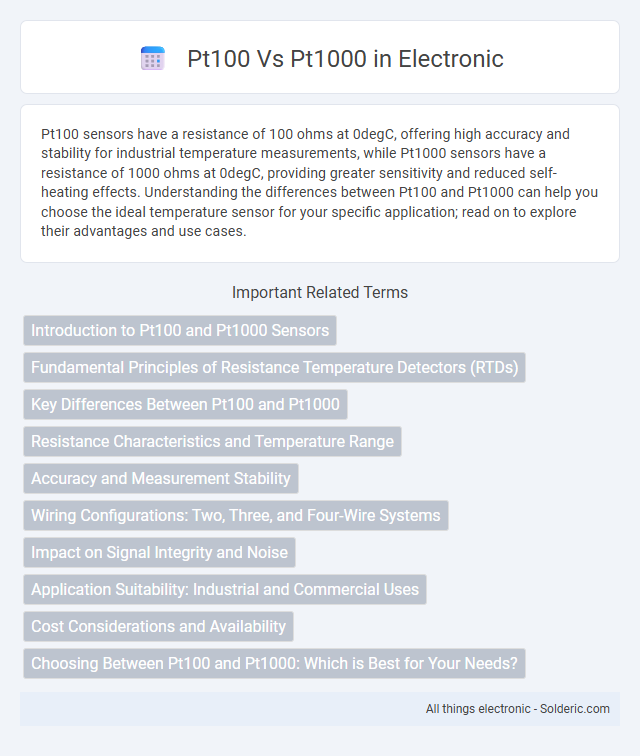Pt100 sensors have a resistance of 100 ohms at 0degC, offering high accuracy and stability for industrial temperature measurements, while Pt1000 sensors have a resistance of 1000 ohms at 0degC, providing greater sensitivity and reduced self-heating effects. Understanding the differences between Pt100 and Pt1000 can help you choose the ideal temperature sensor for your specific application; read on to explore their advantages and use cases.
Comparison Table
| Feature | Pt100 | Pt1000 |
|---|---|---|
| Resistance at 0degC | 100 Ohms | 1000 Ohms |
| Sensitivity | 0.385 Ohms/degC | 3.85 Ohms/degC |
| Accuracy | High | Very High |
| Measurement Range | -200degC to 850degC | -200degC to 850degC |
| Self-Heating | Lower | Higher |
| Cost | Lower | Higher |
| Lead Wire Effect | More significant | Less significant |
| Common Applications | Industrial temperature measurement | Precision temperature sensing |
Introduction to Pt100 and Pt1000 Sensors
Pt100 and Pt1000 sensors are platinum resistance temperature detectors (RTDs) widely used for accurate temperature measurement in industrial applications. Pt100 sensors have a resistance of 100 ohms at 0degC, while Pt1000 sensors feature 1000 ohms at the same temperature, offering higher sensitivity and signal-to-noise ratio. Choosing between Pt100 and Pt1000 depends on your measurement range, wiring length, and precision requirements.
Fundamental Principles of Resistance Temperature Detectors (RTDs)
Pt100 and Pt1000 are types of Resistance Temperature Detectors (RTDs) that operate on the principle of electrical resistance changing with temperature. Pt100 RTDs have a resistance of 100 ohms at 0degC, while Pt1000 RTDs have 1000 ohms at the same temperature, providing different sensitivity and signal levels for temperature measurement. Your selection depends on the required accuracy, signal output, and system compatibility, with Pt1000 offering higher output and better noise immunity in certain applications.
Key Differences Between Pt100 and Pt1000
Pt100 and Pt1000 sensors differ primarily in resistance values, with Pt100 having 100 ohms and Pt1000 1000 ohms at 0degC, affecting sensitivity and signal output. Pt1000 offers higher signal levels making it less susceptible to electrical noise, ideal for long cable runs, while Pt100 provides better compatibility with existing industrial systems. Your choice depends on accuracy requirements and system compatibility, with Pt1000 favored for modern, low-noise applications.
Resistance Characteristics and Temperature Range
Pt100 sensors have a resistance of 100 ohms at 0degC, offering high accuracy and stability over a temperature range typically from -200degC to 850degC, while Pt1000 sensors exhibit 1000 ohms at 0degC, which results in greater sensitivity and better signal-to-noise ratio in low-level signal applications. The temperature coefficient of resistance is similar for both, approximately 0.00385 ohms/ohm/degC, but Pt1000's higher resistance makes it more suitable for environments with long wire runs or electrical noise interference. Your choice depends on balancing the need for precision, signal quality, and environmental conditions in temperature measurement.
Accuracy and Measurement Stability
Pt100 sensors offer high accuracy with typical tolerances of +-0.15degC and excellent measurement stability over a wide temperature range, making them ideal for precise industrial applications. Pt1000 sensors, while slightly less accurate with tolerances around +-0.3degC, provide better sensitivity to temperature changes and improved noise immunity. Your choice between Pt100 and Pt1000 depends on the required accuracy level and measurement stability in your specific environment.
Wiring Configurations: Two, Three, and Four-Wire Systems
Pt100 and Pt1000 sensors differ in wiring configurations where two-wire systems are simplest but prone to lead wire resistance errors, affecting temperature accuracy. Three-wire systems help compensate for lead resistance by using a third wire to balance out uncertainties, making them common in industrial temperature measurements. Four-wire setups provide the most precise readings by completely eliminating lead resistance effects, ideal for critical applications requiring your highest measurement accuracy.
Impact on Signal Integrity and Noise
Pt1000 sensors offer improved signal integrity compared to Pt100 due to their higher resistance, which reduces the impact of lead wire resistance and minimizes voltage drop across long cable runs. The higher output signal level of Pt1000 enhances noise immunity, leading to more accurate temperature measurements in electrically noisy environments. In contrast, Pt100 sensors are more susceptible to signal degradation and noise interference, especially in industrial settings with significant electromagnetic interference.
Application Suitability: Industrial and Commercial Uses
Pt100 sensors provide precise temperature measurement suitable for industrial environments requiring high accuracy and stability over a wide temperature range. Pt1000 sensors offer faster response times and lower power consumption, making them ideal for commercial HVAC systems and applications where sensor size and energy efficiency are priorities. Your choice between Pt100 and Pt1000 depends on the specific industrial or commercial requirements for sensitivity, durability, and operational conditions.
Cost Considerations and Availability
Pt100 sensors generally have lower initial costs compared to Pt1000 sensors due to their widespread use and standardized production. Pt1000 sensors, offering higher resistance and often better signal quality, tend to be more expensive and less commonly stocked by suppliers. Availability of Pt100 sensors is typically broader, with numerous manufacturers and vendors offering a wide range of options, while Pt1000 sensors may require specialized sourcing or longer lead times.
Choosing Between Pt100 and Pt1000: Which is Best for Your Needs?
Choosing between Pt100 and Pt1000 sensors depends on accuracy, application environment, and budget considerations. Pt100 sensors offer higher durability and better performance in industrial settings due to their lower resistance and noise sensitivity, while Pt1000 sensors provide greater sensitivity and faster response times ideal for precise temperature measurements. Understanding your specific requirements ensures that your choice maximizes efficiency and reliability in temperature monitoring.
Pt100 vs Pt1000 Infographic

 solderic.com
solderic.com